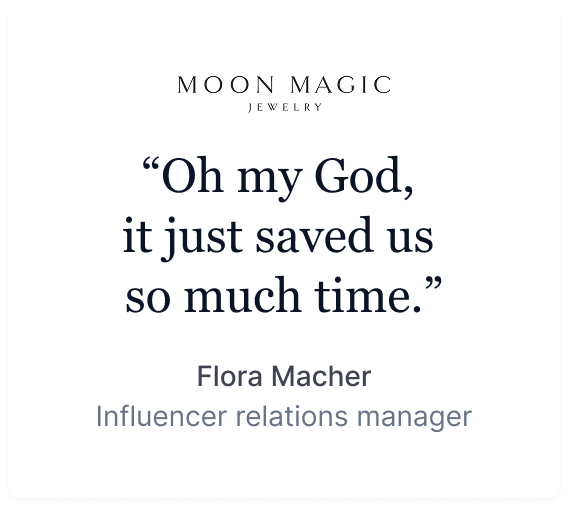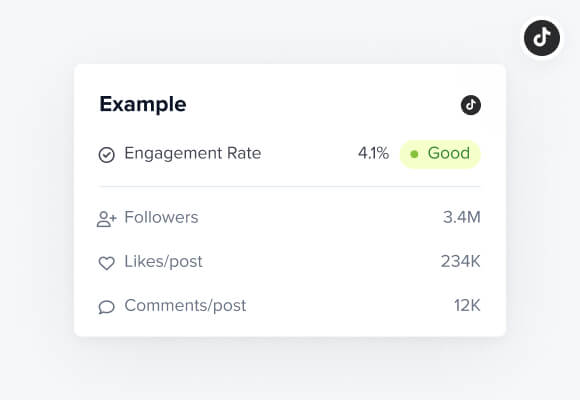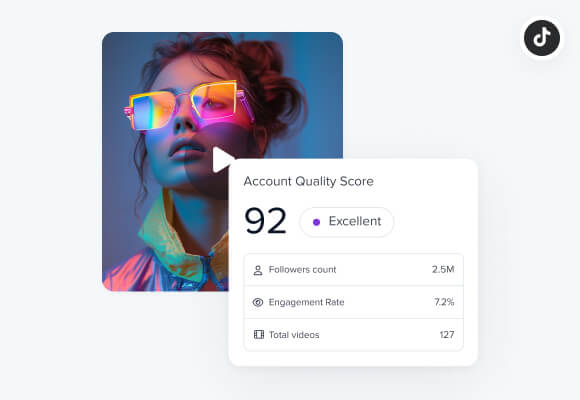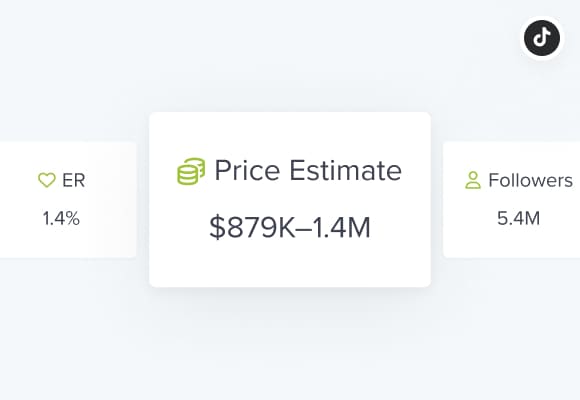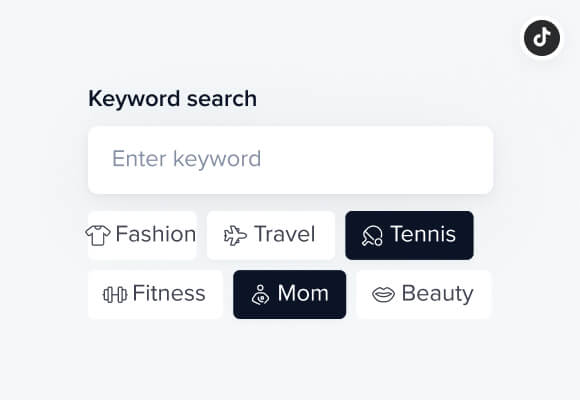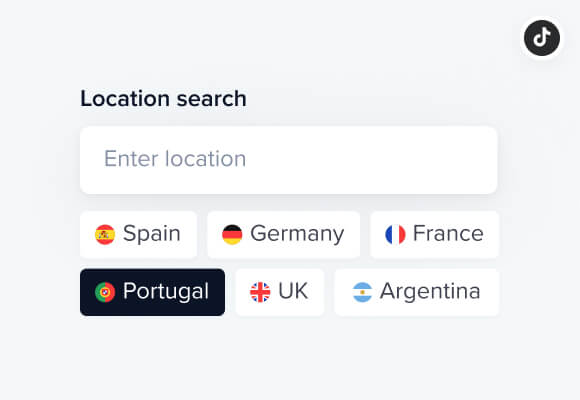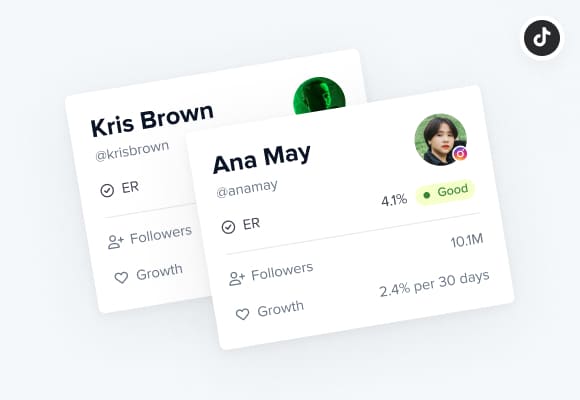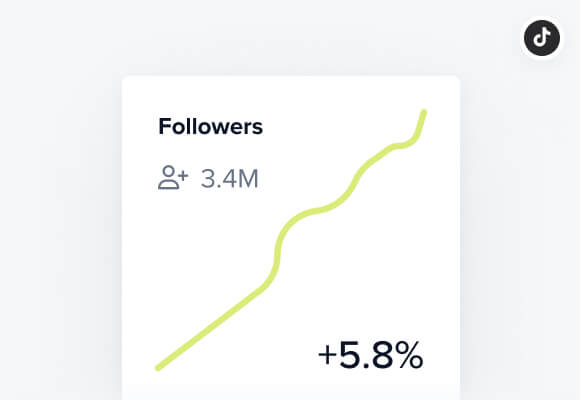Free TikTok Likes-to-Followers Ratio Calculator

Likes are the most common type of engagement on TikTok. A video's likes indicate that viewers found it entertaining or engaging, which can boost its virality. As TikTok's algorithms recommend additional videos on users' FYP based on their preferences, interests, and previously liked videos, even small creators' content can generate massive engagement. For this reason, businesses and marketing specialists should measure likes not only on their own, but also in proportion to the influencer's following.
HypeAuditor’s TikTok Like-to-Follower Ratio calculator enables brands and agencies to gauge the level of interaction an influencer's TikTok post generated. As part of the analysis, the tool quantifies the ratio between the number of likes the video content received and the number of followers the creator has. Marketers can monitor a creator's performance over time by measuring the ratio of likes and followers across multiple videos. This way, businesses can forecast a creator’s performance and make informed decisions about their marketing strategy, influencer selection and estimate their ROI.
TikTok Likes-to-Followers Ratio Calculator Questions
What does the likes-to-follower ratio mean on TikTok?
Likes to followers is an indicator of the average number of likes influencers’ TikTok videos generate relative to the size of their audience. The metric helps brands and agencies evaluate TikTok creators’ content in terms of quality, popularity and engagement. A good ratio suggests that the influencer produces high-quality videos that many people enjoy and like, while a bad ratio indicates that the TikToker needs to refine their content strategy. However, brands must also consider a handful of other KPIs, such as the like to view ratio, engagement rate, average views per posts, viral potential and likes growth, when assessing TikTok influencers’ performance.
How is a TikTok creator’s like ratio calculated?
To estimate the follower vs like TikTok ratio, select the video whose engagement value you are interested in. Write down the number of likes the specific post received and the number of followers the account has had when the video was published. With these data at your hands, you can count the likes to followers ratio with the formula below:
(Average number of likes / the number of followers) * 100
Let’s say, a user posted a video that got 200 likes and the account has had 5,000 followers, so the like ratio will be: (200 / 5,000) * 100 = 4%
Bear in mind that this number provides a snapshot of the engagement level of one video. To get a better understanding of a content creator’s overall performance you must calculate the likes vs followers rate across multiple posts for a longer period. Also, the longer your calculation spans, the more likely it is that the number of followers was lower than the current number. For this reason, it is better to calculate the like TikTok ratio for periods of 30, 60 or 90 days.
What is a good ratio of likes to followers on TikTok?
There isn’t a set standard for likes-to-followers on TikTok, but content with a ratio between 1% and 3% is considered good. According to the above example, if the account has a following of 5,000 users, its content must receive at least 50 likes on average to have a ratio of 1%. For the same user, an average of over 150 likes is a very good ratio of likes to followers as it exceeds 3%.
Naturally, the ratio of likes to followers can depend on multiple factors, including the creator’s niche, content quality, their connection with their audience, involvement in broad and niche-specific TikTok trends, the audience’s engagement and their efforts promoting their content across several platforms.
Are likes or followers more important on TikTok?
They are closely interrelated, so they are both important. When TikTok recommends videos for users' For You Pages, it considers both metrics, but it doesn't rely merely on them. In general, bigger accounts have a wider reach and are more visible on the platform, which means they receive more likes since people are actively searching for their content. Still, follower count doesn’t solely affect what video is featured on users’ feed.
Besides the number of likes and followers, TikTok's algorithms suggest videos based on additional factors, including what content a user likes and shares, what posts they add to their favorites, and what accounts they follow. It monitors what videos an individual watches or rewatches, and what captions, sounds, trending topics, and hashtags they search for. Engaging and informative videos by influencers with fewer followers have the same chance of taking off and generating many likes as well-known TikTok stars.
Additionally, responding to comments, connecting with followers, and participating in challenges can boost the number of likes regardless of how big a creator's audience is. The result will be an increase in their like-to-follower ratio, which will result in audience growth as well. Therefore, brands and agencies should also study the TikTok analytics of lesser known creators, because their low follower counts and high engagement levels allow them to produce even greater results.
What does it mean if an influencer's follower to like ratio drops on TikTok?
Before assuming the worst, drops in the follower to like ratio doen’t always equal a downturn in performance. Temporarily, the value may go into a negative trend and there may be several reasons for this.
- Changing content strategies, like experimenting with new formats or topics, can decrease the number of likes relative to followers. The influencer's audience may take time to adjust to the new posts or style, so businesses shouldn't draw immediate conclusions.
- Followers change as well. A decline in the ratio may be attributed to a shift in audience demographics or preferences. This again negatively influences the engagement level and causes lower likes to followers ratios.
- TikTok's main goal is to entertain users for as long as possible. The platform's algorithms constantly evolve and undergo several modifications to keep up with user behavior and emerging trends. This can cause influencers' content to be shown to a different audience or be exposed to fewer people than before, decreasing their ratio.
- Those who don't participate in TikTok trends or challenges relevant to their topic or publish consistently the same content may experience a reduction in their audience’s engagement.
Is a bad ratio a red flag for brands?
Temporary decreases shouldn't be confused with low ratios. The former doesn’t justify rejecting an influential partnership. Nevertheless, if the negative trend continues, a comprehensive analysis of influencer metrics is strongly recommended.
- Losing followers: TikTok's main audience is very young with a short attention span and gets bored very easily. The platform attracts them because of its trending effects, sounds, topics, memes and challenges. Creators who miss out on these trends will lose their followers.
- Content quality: When content quality gradually deteriorates, audiences can lose interest.
- Less engagement: It follows from the above that disinterested followers don’t or seldomly interact with the posts.
- Audience quality: TikTok faces the same problem as other social media platforms in which influencers may fraudulently increase their followers.
- Inconsistent posting: Only those who post consistently will stay on top.
